Related Research Articles

Wolf–Rayet stars, often abbreviated as WR stars, are a rare heterogeneous set of stars with unusual spectra showing prominent broad emission lines of ionised helium and highly ionised nitrogen or carbon. The spectra indicate very high surface enhancement of heavy elements, depletion of hydrogen, and strong stellar winds. The surface temperatures of known Wolf–Rayet stars range from 20,000 K to around 210,000 K, hotter than almost all other kinds of stars. They were previously called W-type stars referring to their spectral classification.

EZ Canis Majoris is binary system in the constellation of Canis Major. The primary is a Wolf-Rayet star and it is one of the ten brightest Wolf-Rayet stars, brighter than apparent magnitude 7.

WR 22, also known as V429 Carinae or HR 4188, is an eclipsing binary star system in the constellation Carina. The system contains a Wolf-Rayet (WR) star that is one of the most massive and most luminous stars known, and is also a bright X-ray source due to colliding winds with a less massive O class companion. Its eclipsing nature and apparent magnitude make it very useful for constraining the properties of luminous hydrogen-rich WR stars.
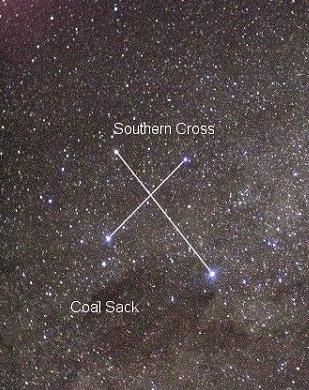
WR 46 is a Wolf-Rayet star in the constellation of the Southern Cross of apparent magnitude +10.8. It is located at 55 arcmin north of Theta2 Crucis. The star is a member of the distant stellar association Cru OB4, and is around 2,900 parsecs or 9,300 light years from the Solar System.

WR 25 is a binary star system in the turbulent star-forming region the Carina Nebula, about 6,800 light-years from Earth. It contains a Wolf-Rayet star and a hot luminous companion and is a member of the Trumpler 16 cluster. The name comes from the Catalogue of Galactic Wolf–Rayet Stars.

WR 24 is a Wolf-Rayet star in the constellation Carina. It is one of the most luminous stars known. At the edge of naked eye visibility it is also one of the brightest Wolf Rayet stars in the sky.
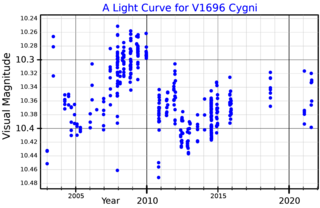
WR 148 is a spectroscopic binary in the constellation Cygnus. The primary star is a Wolf–Rayet star and one of the most luminous stars known. The secondary has been suspected of being a stellar-mass black hole but may be a class O main sequence star.
WR 156 is a young massive and luminous Wolf–Rayet star in the constellation of Cepheus. Although it shows a WR spectrum, it is thought to be a young star still fusing hydrogen in its core.
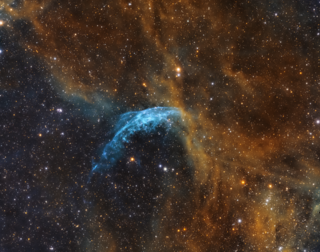
WR 134 is a variable Wolf-Rayet star located around 6,000 light years away from Earth in the constellation of Cygnus, surrounded by a faint bubble nebula blown by the intense radiation and fast wind from the star. It is five times the radius of the sun, but due to a temperature over 63,000 K it is 400,000 times as luminous as the Sun.
WR 142 is a Wolf-Rayet star in the constellation Cygnus, an extremely rare star on the WO oxygen sequence. It is a luminous and very hot star, highly evolved and close to exploding as a supernova. It is suspected to be a binary star with a companion orbiting about 1 AU away.

WR 102 is a Wolf–Rayet star in the constellation Sagittarius, an extremely rare star on the WO oxygen sequence. It is a luminous and very hot star, highly evolved and close to exploding as a supernova.

WR 93b is a Wolf-Rayet star in the constellation Scorpius, an extremely rare star on the WO oxygen sequence. It appears near NGC 6357 in the tail of the scorpion.
WR 135 is a variable Wolf-Rayet star located around 6,000 light years away from Earth in the constellation of Cygnus, surrounded by a faint bubble nebula blown by the intense radiation and fast wind from the star. It is just over four times the radius of the sun, but due to a temperature of 63,000 K it is 250,000 times as luminous as the sun.

WR 137 is a variable Wolf-Rayet star located around 6,000 light years away from Earth in the constellation of Cygnus.
WR 111 is a Wolf-Rayet (WR) star in the constellation Sagittarius. It is magnitude 7.8 and lies about 5,150 light-years away. It is one of the brightest and most closely studied WR stars.
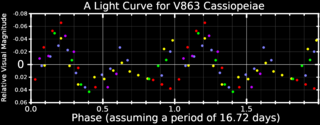
WR 1 is a Wolf-Rayet star located around 10,300 light years away from Earth in the constellation of Cassiopeia. It is only slightly more than twice the size of the sun, but due to a temperature over 100,000 K it is over 758,000 times as luminous as the sun.
WR 2 is a Wolf-Rayet star located around 8,000 light years away from Earth in the constellation of Cassiopeia, in the stellar association Cassiopeia OB1. It is smaller than the Sun, but due to a temperature over 140,000 K it is 282,000 times as luminous as the Sun. With a radius of 89% that of the Sun, it is the smallest known WN star in the Milky Way.
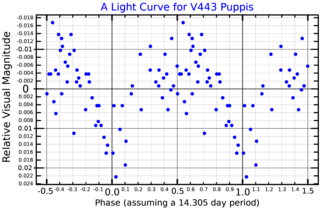
WR 9 is a spectroscopic binary in the constellation Puppis consisting of a Wolf-Rayet star and a class O star. It is around 12,000 light years away.
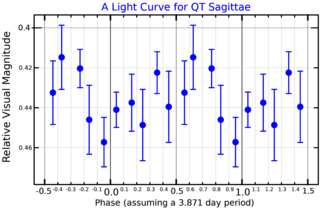
WR 128 is a Wolf–Rayet star located about 9,500 light years away in the constellation of Sagitta. A member of the WN class, WR 128's spectrum resembles that of a WN4 star, but hydrogen is clearly present in the star, making it the only known hydrogen-rich WN4 star in the galaxy. However, similar H-rich very early WN stars can be found in the LMC and especially in the SMC, but the only other galactic examples of this are WR 3 and WR 152.
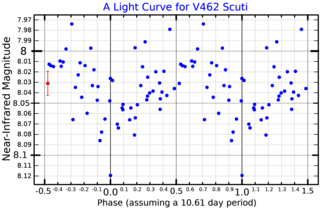
WR 120 is a binary containing two Wolf-Rayet stars in the constellation of Scutum, around 10,000 light years away. The primary is a hydrogen-free weak-lined WN7 star, the secondary is a hydrogen-free WN3 or 4 star, and the system is a possible member of the cluster Dolidze 33. From our point of view, WR 120 is reddened by 4.82 magnitudes, and it has the variable designation of V462 Scuti.
References
- 1 2 Van Leeuwen, F. (2007). "Validation of the new Hipparcos reduction". Astronomy and Astrophysics. 474 (2): 653–664. arXiv: 0708.1752 . Bibcode:2007A&A...474..653V. doi:10.1051/0004-6361:20078357. S2CID 18759600.
- 1 2 3 Ducati, J. R. (2002). "VizieR Online Data Catalog: Catalogue of Stellar Photometry in Johnson's 11-color system". CDS/ADC Collection of Electronic Catalogues. 2237. Bibcode:2002yCat.2237....0D.
- 1 2 3 4 5 6 7 Sota, A.; Maíz Apellániz, J.; Morrell, N. I.; Barbá, R. H.; Walborn, N. R.; Gamen, R. C.; Arias, J. I.; Alfaro, E. J.; Oskinova, L. M. (2019). "The Galactic WN stars revisited. Impact of Gaia distances on fundamental stellar parameters". Astronomy & Astrophysics. A57: 625. arXiv: 1904.04687 . Bibcode:2019A&A...625A..57H. doi:10.1051/0004-6361/201834850. S2CID 104292503.
- ↑ Kharchenko, N. V.; Scholz, R.-D.; Piskunov, A. E.; Röser, S.; Schilbach, E. (2007). "Astrophysical supplements to the ASCC-2.5: Ia. Radial velocities of ˜55000 stars and mean radial velocities of 516 Galactic open clusters and associations". Astronomische Nachrichten. 328 (9): 889. arXiv: 0705.0878 . Bibcode:2007AN....328..889K. doi:10.1002/asna.200710776. S2CID 119323941.
- 1 2 3 Brown, A. G. A.; et al. (Gaia collaboration) (August 2018). "Gaia Data Release 2: Summary of the contents and survey properties". Astronomy & Astrophysics . 616. A1. arXiv: 1804.09365 . Bibcode: 2018A&A...616A...1G . doi: 10.1051/0004-6361/201833051 . Gaia DR2 record for this source at VizieR.
- ↑ Crowther, Paul A.; Rate, Gemma (2020). "Unlocking Galactic Wolf–Rayet stars with Gaia DR2 – I. Distances and absolute magnitudes". Monthly Notices of the Royal Astronomical Society. 493 (1): 1512–1529. arXiv: 1912.10125 . Bibcode:2020MNRAS.493.1512R. doi: 10.1093/mnras/stz3614 . S2CID 209444955.
- ↑ Hiltner, W. A.; Schild, R. E. (1966). "Spectral Classification of Wolf-Rayet Stars". Astrophysical Journal. 143: 770. Bibcode:1966ApJ...143..770H. doi:10.1086/148556.
- ↑ Marchenko, S. V.; Moffat, A. F. J.; Crowther, P. A.; Chené, A.-N.; De Serres, M.; Eenens, P. R. J.; Hill, G. M.; Moran, J.; Morel, T. (2004). "Hydrogen in the atmosphere of the evolved WN3 Wolf-Rayet star WR 3: Defying an evolutionary paradigm?" (PDF). Monthly Notices of the Royal Astronomical Society. 353 (1): 153–161. Bibcode:2004MNRAS.353..153M. doi: 10.1111/j.1365-2966.2004.08058.x .
- ↑ Van Der Hucht, Karel A.; Conti, Peter S.; Lundström, Ingemar; Stenholm, Björn (1981). "The Sixth Catalogue of galactic Wolf-Rayet stars, their past and present". Space Science Reviews. 28 (3): 227–306. Bibcode:1981SSRv...28..227V. doi:10.1007/BF00173260. S2CID 121477300.
- ↑ Smith, Nathan; Conti, Peter S. (2008). "On the Role of the WNH Phase in the Evolution of Very Massive Stars: Enabling the LBV Instability with Feedback". The Astrophysical Journal. 679 (2): 1467–1477. arXiv: 0802.1742 . Bibcode:2008ApJ...679.1467S. doi:10.1086/586885. S2CID 15529810.